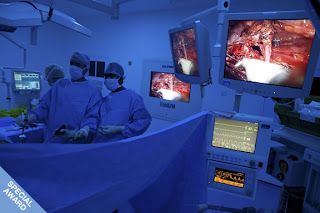Here are some key learning points I picked up from todays talks:
1. The Role of the Forensic Pathologist
Atherosclerotic cardiovascular disease is the most common primary cause of death on a death certificate. A post-mortem examination should never be carried out without the context of the death being known ie. what the circumstances of the death were. The aim of the autopsy is to work out the cause of death, the mechanism of death and the manner of death.
2. Witness Familiarisation
This talk was all about what to expect if asked to attend court as a witness. It was interesting to give an insight into how the court system works. Familiaristation is now recommended for all witnesses but it is important to stress that this is not the same as "coaching" which is an illegal process where witnesses are coached on what to say when cross-examined in court. Most people who go to courts are disadvantaged by ignorance of the court process. In Scotland there are three courts: high court, sheriff court and district/JP court.
3. Forensic Psychiatry
The Mental Health (Care + Treatment) Scotland Act (2003) applies to forensic psychiatry patients. CORO is a type of restraining order. Detaining someone in hospital is effectively "taking away somebody's freedom in order to treat them". These patients do not have insight into their conditions. For a successful outcome, reciprocity is of paramount importance. Balanced attitudes towards offenders is required. Have the ability to step back and not get involved with what patients have done in the past. The role of the doctor is not to be judgemental.
Folie A Deux is "shared psychosis", a rare psychiatric phenomenon where symptoms of a delusion are transferred from one person to another.
Paediatric Symposium:
1. Paediatric Prescribing
Lack of evidence in paediatrics leads to increased errors in prescribing. In children there are changes in absorption, distribution, metabolism and excretion. IM injections should be avoided in children where possible. For IV injections / cannulas, local anaesthetic cream can help. Dose calculation is based on age, weight and surface area but the dose MUST NOT exceed the adult dose. Round off the calulated dose for easier administration. Be careful with DECIMAL POINTS! Be very cautious about ALLERGIES in children. Licensed medicines should be used but this is not always possible. A good idea is to keep a prescribing checklist ie. dose and frequency of medications. If prescribing unlicensed products, the prescriber must take full responsibility.
2. Cystic Fibrosis
Scottish newborn screening for CF was introduced in 2003. Presentations of CF: newborn screening, failure to thrive, steatorrhoea and recurrent LRTIs. There are >8000 patients in the UK with CF today. Males generally live longer than females. Respiratory failure is the commonest cause of death. CFTR channel is anapical membrane chloride channel of exocrine epithelial cells which is defective. CFTR gene is located on chromosome 7. Respiratory exacerbations of CF can be identified by change in sputum colour/volume, increased cough, dyspnoea, haemoptysis, fatigue, lethargy, fever and weight loss. Meconium ileus presents in the newborn period with bowel obstruction and insippated viscid meconium in the bowel. Laparotomy, small bowel resection and temporary ileostomy may be required. Pancreatic insufficiency occurs in 85% of patients with CF. A,D,E and K are fat soluble vitamins. CF related diabetes occurs in 12% of CF patients age 15-19 years. Young women with CF often develop secondary amenorrhoea and men are almost always infertile.
3. Childhood Leukaemia
Dramatic improvements in survival rates have occurred in the past 30 years. AML and ALL are the most common forms of childhood leukaemia in children. Leukaemia is the commonest form of cancer seen in childhood.
4. Faints, Fits and Funny Turns
Seizure is a transient abnormal excessive discharge of neurons residing primarily in the cerebral cortex. The diagnosis is ALL IN THE HISTORY. Status epilepticus is the commonest neurological emergency. Ask how the child's general school development has been. A witness report of a seizure is VERY IMPORTANT. What were they doing at the time, sleeping? LOTS of differential diagnoses exist which are NOT epilepsy. Day dreams and absence seizures can be hard to tell apart. Absence seizures never last more than 30 seconds. Cardiac symptoms of a vaso-vagal attack include sweating, palpitations, pallor, tunnel vision are tinnitus. Conscious level tends to return FAST (unlike in epilepsy). Investigations are often not require. Negative effects of too many tests can include excessive worry and anxiety for the family.
5. Neonate - Newborn Examination
Cephalohaematoma doesn't cross suture lines. Caput succadaneum can cross suture lines. Thin upper lip, smooth philtrum - signs include fetal alcohol syndrome. Pre-auricular skin tags can be a sign of kidney disease. Barlows/Ortolani's tests are only 30% - 40% sensitive. Erb's Palsy (birth trauma) leads to the "waiter's tip" sign. Erythema toxicum is a harmless dermatological syndrome.
6. Neonatal Transport
Fascinating lecture from one of the new paediatric consultants in Ninewells on his experiences transferring neonates between hospitals in England, Scotland and Australia. ECMO stands for extra-corporeal membrane oxygenation.





